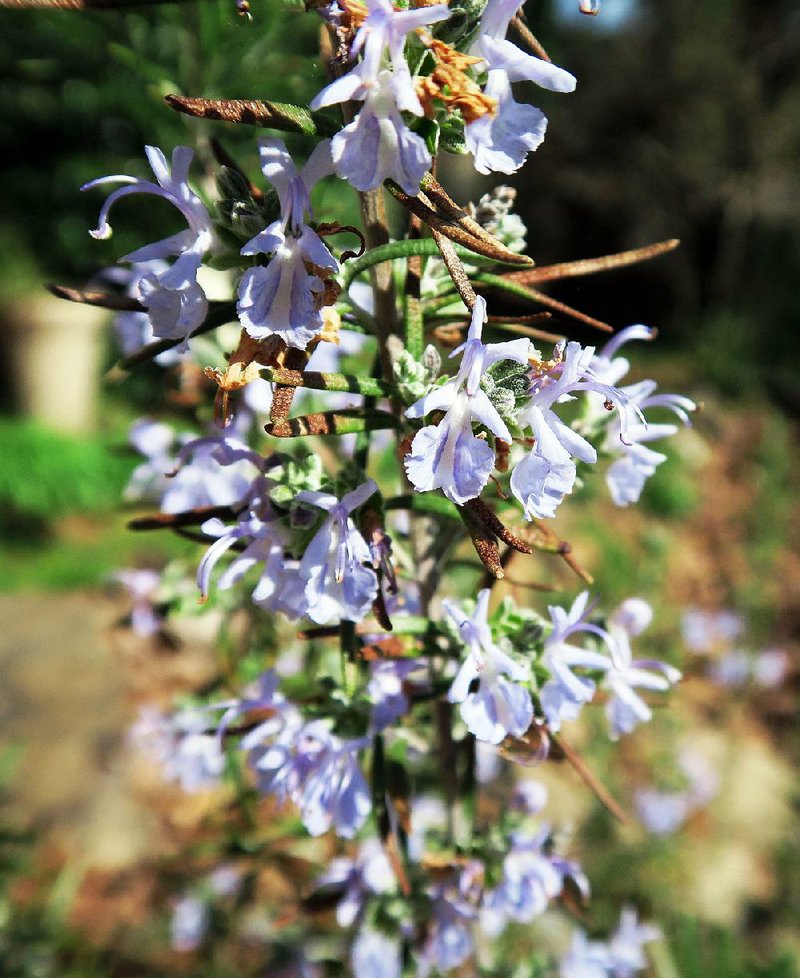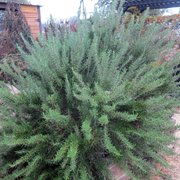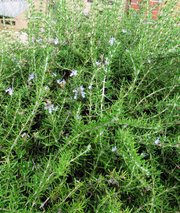Rosemary is an evergreen herb native to the Mediterranean coast that is steeped in tradition.
It has been used as a symbol of loyalty, friendship and remembrance. It has been carried by the bride at her wedding and by mourners at funerals. Today, rosemary is being used as a drought-tolerant shrub as well as a culinary herb.
A member of the Labiatae (mint) family, rosemary plants can be upright or prostrate in growth habit.
• It takes several years, but upright forms will grow to 3 or 4 feet or taller.
• The prostrate, or creeping, forms are less winter hardy and only reach 8 to 10 inches tall, but they make an elegant ground cover and will cascade over a ledge.
The stems of rosemary become woody with age. They are covered with green, needlelike foliage year-round. They have pale blue or white
blooms in the winter or spring, depending on the variety.
Rosemary can be planted in the ground or in containers.
Most varieties will overwinter in the southern two-thirds of Arkansas just fine, but they can be nipped back or even killed in a severely cold winter up north. Die-back is also possible in central Arkansas.
Although gardeners in the northern tier of counties might struggle to maintain rosemary as a permanent plant, many gardeners grow it as a short-lived perennial or a container plant that they protect from winter weather.
PIG IN A POKE
There are many species of rosemary with a variability to winter hardiness. Often at garden centers the plants are labeled merely "Rosemary," so shoppers don't know the variety they're getting.
And variety matters. Rosemary can be used in a stand-alone herb garden, interspersed with other perennials and shrubs or used as a hedge, depending on variety.
"Arp" and "Madeline Hill" are two of the more cold-tolerant varieties for Arkansas.
As the holidays approach each fall, you will see offerings of rosemary shaped like a Christmas tree and other topiary shapes for sale. These can be hard to overwinter indoors and out, as their pot size is relatively small, making them less winter hardy. Meanwhile, growing rosemary indoors in the winter can be a challenge. Overwatering is a death knell, and the warm yet low-humidity environment indoors can be tough on the plants.
NOT HOUSEPLANTS
If you do take one inside, remove any foil wraps, and water sparingly. Place the plant in a sunny window in one of the coolest rooms of your house.
Don't try to grow them indoors year-round.
If you choose to keep newly acquired rosemary plants outdoors, put them in a larger container or be prepared to move them to a sheltered location when the temperatures dip much below freezing.
MAKE YOUR OWN
Most people buy rosemary plants, because growing them from seed is time-consuming. If you already own a plant, they propagate readily from cuttings or, even more easily, layering.
Place a low-growing branch along the soil line, mound some soil over the stem and weight it down with a rock or brick. The part that is underground will produce roots. Once rooted, you can cut it off and have a new plant.
NO WET FEET
Rosemary thrives in full sun, but will grow in partial shade, provided you have an extremely well-drained soil. Heavy soils will not give you great results. Some gardeners mulch their plants with coarse sand or chicken grit. If you have heavy soils, raise the level of planting.
Winter drainage is critical. If the plants stand in water, they won't last long.
On the flip side, if our winters are particularly dry, watering prior to a cold snap can bolster the plants' hardiness. A dry plant has no buffer from freezing, while one with ample water in its system has a bit more protection.
SPREAD THE AROMA
Rosemary is used by many cooks for a wide array of recipes. From meat and potatoes to salads, breads and even some desserts and drinks. It has an assertive flavor that unlike most other herbs is actually stronger fresh than after it has dried.
Throw a few sprigs into your fireplace to spread the aroma.
If you are using just the leaves, for instance, in cooking, after you strip the stems of their leaves you can use the stems as skewers for shish kebabs. The stem imparts its flavor from the inside out to meats and vegetables. Dead plants can also lend their stems to shish kebab.
Since it is a permanent addition in most gardens, be careful when harvesting, judiciously removing stems from around the plant.
Rosemary is a great addition to any sunny garden. Its fragrant and useful foliage is great in the kitchen, but if you find a good spot for this plant, it can be as tough as it is useful. And the lovely small blooms you'll see intermittently from fall through spring are enjoyed by bees.
As with most herbs, it has very few pest problems, and will rarely be damaged by wildlife.
Janet B. Carson is a horticulture specialist for the University of Arkansas Cooperative Extension Service.
HomeStyle on 12/16/2017



